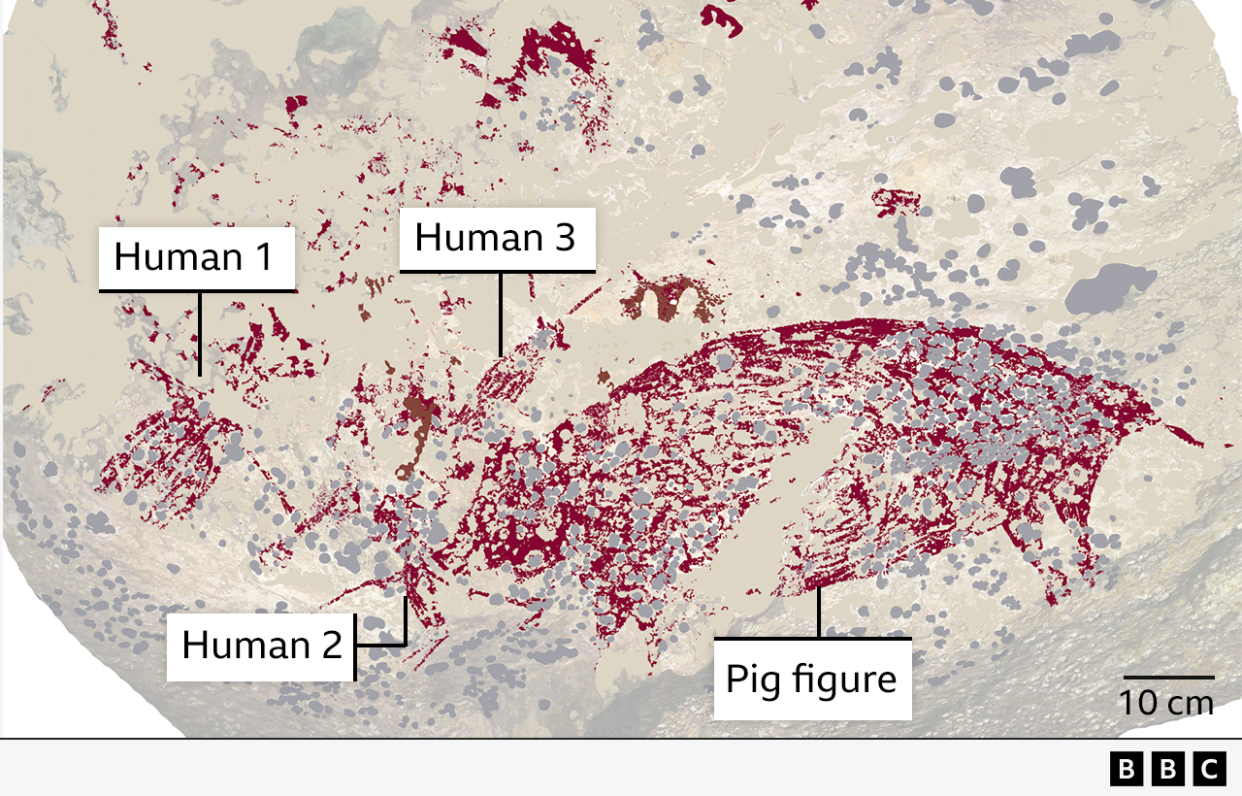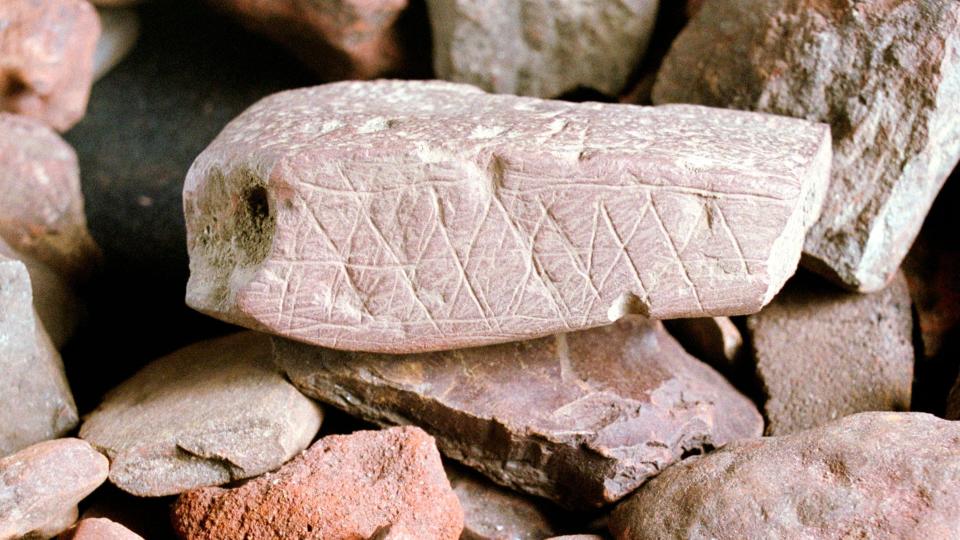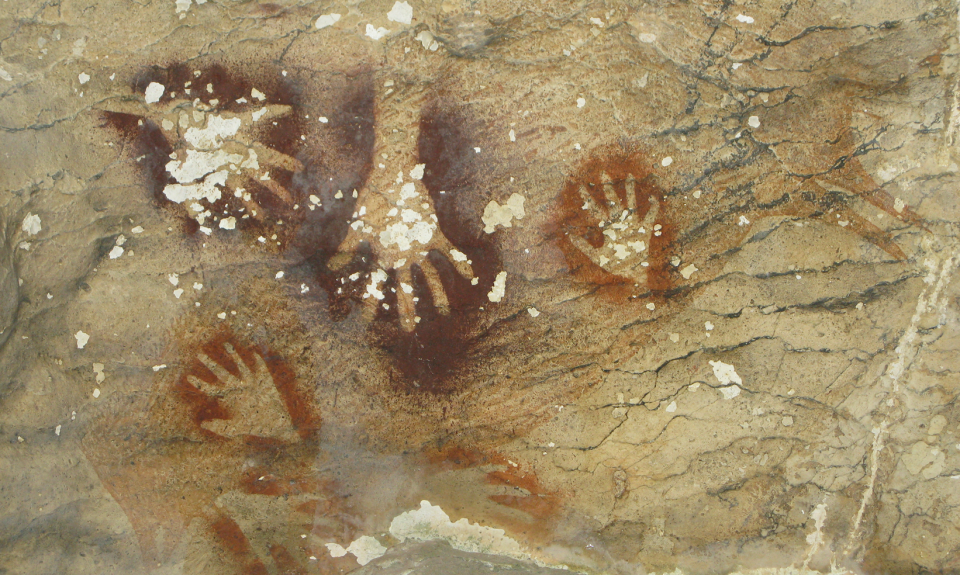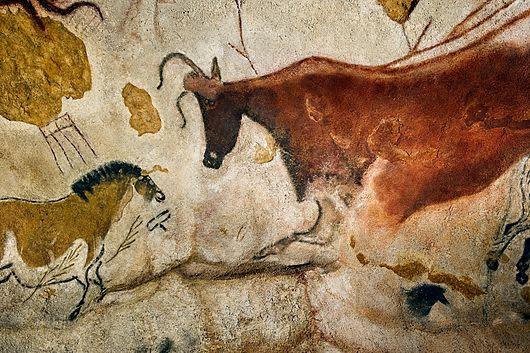World's oldest cave art found showing humans and pig

The oldest example of figurative cave art has been discovered in the Indonesian Island of South Sulawesi by Australian and Indonesian scientists.
The painting of a wild pig and three human-like figures is at least 51,200 years old, more than 5,000 years older than the previous oldest cave art.
The discovery pushes back the time that modern humans first showed the capacity for creative thought.
Prof Maxime Aubert from Griffith University in Australia told BBC News that the discovery would change ideas about human evolution.
“The painting tells a complex story. It is the oldest evidence we have for storytelling. It shows that humans at the time had the capacity to think in abstract terms,” he said.
The painting shows a pig standing still with its mouth partly open and at least three human-like figures.
The largest human figure has both arms extended and appears to be holding a rod. The second is immediately in front of the pig with its head next to its snout. It also seems to be holding a stick, one end of which may be in contact with the pig’s throat. The last human-like figure seems to be upside-down with its legs facing up and splayed outwards. It has one hand reaching towards and seemingly touching the pig’s head.
The team of scientists was led by Adhi Agus Oktaviana, an Indonesian rock art specialist from the National Research and Innovation Agency (BRIN) in Jakarta. He says that that narrative storytelling was a crucial part of early human culture in Indonesia from a very early point in time.
“Humans have probably been telling stories for much longer than 51,200 years, but as words do not fossilise we can only go by indirect proxies like depictions of scenes in art – and the Sulawesi art is now the oldest such evidence by far that is known to archaeology,” he said.

The first evidence for drawing on stones found in the Blombos Caves in southern Africa dating back to between 75,000 to 100,000 years ago. These consist of geometric patterns.
The new painting, in the limestone cave of Leang Karampuang in the Maros-Pangkep region of South Sulawesi, shows representational art – and abstract representation of the world around the person or people that painted it. It therefore represents an evolution in the thought processes in our species that gave rise to art and science.
The question is what triggered this awakening of the human mind, according to Dr Henry Gee, who is a senior editor at the journal Nature, where the details were published.
“Something seems to have happened around 50,000 years ago, shortly after which all other species of human such as Neanderthals and the so-called Hobbit died out.
“It is very romantic to think that at some point in that time something happened in the human brain, but I think it is more likely that there are even earlier examples of representational art”.

Prof Chris Stringer of the Natural History Museum in London believes that there may be examples of ancient representational art in Africa, where modern humans first evolved, but we have not found any yet.
“This find reinforces the idea that representational art was first produced in Africa, before 50,000 years ago, and the concept spread as our species spread.
“If that is true, much new supporting evidence from other areas including Africa has yet to emerge. Obviously this oldest date is work on one panel at one site - hopefully more dating will be done at more sites to confirm this apparently crucial finding”.
The new dating was made possible using a new method which involves cutting tiny amounts of the art using a laser. This enables researchers to study different parts of the artwork in greater detail and come up with a more accurate dating.
As the new method becomes more widely used, several sites with cave art across the world may be re-dated, possibly pushing back further the emergence of representational art.

Until 10 years ago, the only evidence of ancient cave art was found in places such as Spain and Southern France. It led some to believe that the creative explosion that led to the art and science we know today began in Europe.
But the discovery of coloured outlines of human hands in South Suluwesi in 2014 shattered that view
Then in November 2018, in the cave of Lubang Jeriji Saléh on the Indonesian Island of Borneo, scientists found the then oldest representational artwork, thought to be more than 40,000 years old, of an unknown animal.
Prof Adam Brumm from Griffith University said that the latest Indonesian cave art discoveries cast new light on the important role of storytelling in the history of art.
“It is noteworthy that the oldest cave art we have found in Sulawesi thus far consists of recognisable scenes: that is, paintings that depict humans and animals interacting in such a way that we can infer the artist intended to communicate a narrative of some kind – a story,” he said.

